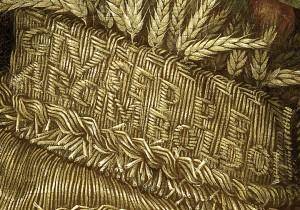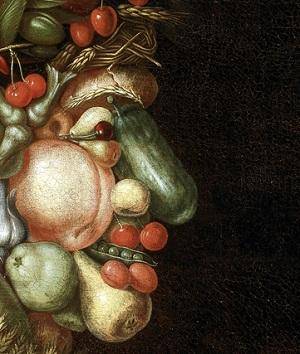Summer
- Giuseppe Arcimboldo, Italian, 1527-1593
Giuseppe Arcimboldo [jew-SEP-pay arch-im-BOLD-OH] was born to a distinguished family in Milan, Italy, and began working as an artist at the Milan Cathedral, creating stained glass, fabrics, and paintings. His father, a painter, probably provided his early training. As the official artist and Master of Festivals for three successive German Emperors, Arcimboldo designed costumes, stage settings, chariots, and other diversions for courtly events and ceremonies. He was also in charge of making acquisitions for the royal cabinet of curiosities, which included art, antiques, curios, oddities of nature, and exotic animals and birds. He engineered creative water works, and even dreamed up a “color-piano” that was played by court musicians. He was perfect for the job and was richly rewarded for his inventiveness.
Arcimboldo was best known for his fantastical “composite head” paintings. These were portraits composed of objects such as fruit, flowers, books, or even a plate of meat. During his time, he acquired international fame and the public reacted to his paintings much the way we do today: with admiration, humor, and fascination. Summer belongs to a set of four paintings that depict the four seasons of the year. Arcimboldo and his workshop painted numerous copies of this set, as did many imitators of the master.
Arcimboldo, a master of allegory, painted each portrait in the Four Seasons series using vegetation associated with that time of year. While his paintings amused and fascinated wealthy courtiers with their apparent whimsy, they also appealed to the intellect. For this set, Arcimboldo suggested that each season corresponds to a stage of human life: Spring stands for youth; Winter, old age; and Summer shows a man in his prime. The series also carried a specific political message—the paintings were meant to symbolically glorify the Emperor. As an Emperor ruled over human affairs, he could also be said to run the greater world, including the seasons. The harmonious combinations of fruit and vegetables reflect the harmony that exists under the Emperor’s rule. Each head also wears something that can be seen as a wreath or a crown. Because of the underlying political messages, these paintings were the perfect, flattering gift for the German Emperors to give to other courts.
Details

The Artist’s “Signature”
The artist’s name is woven into the wheat on Summer’s collar. The date 1572 can be found on his shoulder.

Illusion
Arcimboldo painted each piece of fruit realistically and arranged them to form an actual human face, imitating skin and musculature, all the while creating a character with personality. A row of peas in a pod make for perfectly spaced teeth, while ripe cherries form plump lips. A round peach creates the perfect rosy cheek and a cucumber imitates a bumpy weathered nose.

Profile
The profile format of this painting was probably inspired by portrait heads of Roman emperors, known to Renaissance artists as depicted on Roman coinage. By using the same format in his portraits, Arcimboldo associated Emperor Rudolph II—to whom these works were linked—with a powerful Roman emperor.

The Season’s Harvest
Summer depicts green grapes, plums, mulberries, melon, hazelnuts, assorted pears, cherries, peaches, corn, garlic bulbs, onions, pea pods, eggplant, various squashes, cucumber, artichokes, and wheat.
More Resources
Arcimboldo: Nature and Fantasy
Produced by the National Gallery of Art, this video discusses the career of Arcimboldo. Look out for Summer and Arcimboldo's other paintings of seasons.
Websites
The Louvre Museum
From the Louvre, images of all four season paintings by Arcimboldo.
World Images Kiosk of the California State University
A collection of Arcimboldo portraits.
The Web Gallery of Art
Additional images of Arcimboldo’s works.
Books
Ferino-Pagden, Sylvia. Arcimboldo: 1526-1593. Milano, Italy : Skira ; New York, NY: Distributed in North America by Rizzoli International, 2007.
A comprehensive text on Giuseppe Arcimboldo’s life and work.
Kaufmann, Thomas DaCosta. The Mastery of Nature: Aspects of Art, Science, and Humanism in the Renaissance. Princeton, NJ: Princeton University Press, 1993, pp.100-126.
See pages 100-126 for a detailed discussion of the 16th century allegorical meanings in Arcimboldo’s paintings.
Leppert, Richard D.. Art and the Committed Eye: The Cultural Functions of Imagery. Boulder, Colorado: Westview Press, 1996.
A discussion of the portraits by Arcimboldo as comments on the sitter’s position in society, rather than individual portraits (see Transformations in Chapter 7).
Maiorino, Giancarlo. The Portrait of Eccentricity: Arcimboldo and the Mannerist Grotesque. University Park: Pennsylvania State University Press, 1991.
A comparative text, discussing the work of artist Giuseppe Arcimboldo, critic-historian Giorgio Vasari, and theorist Gregorio Comanini.
Hulten, Pontus, ed. The Arcimboldo Effect: Transformations of the Face from the 16th to the 20th Century. New York: Abbeville Press, 1987.
An explanation of the artist, his influence and inspiration (see essays "The Imperial Court in the Time of Arcimboldo," "The Museum as Image of the World," and "The Allegories and Their Meaning").
Children's Books
Strand, Claudia. Hello Fruit Face!: The Paintings of Giuseppe Arcimboldo. Munich, NY: Prestel Publishing, 1999.
Aimed at grades 4-8, this book provides an easy-to-understand biography and explanation of symbolism in Arcimboldo’s work.
Cognard, Louise. Sticker Art Shapes: Arcimboldo: With More Than 70 Reusable Stickers! United Kingdom: Frances Lincoln Children's Books, 2008.
A wonderful collection of Arcimboldo’s paintings which children can recreate with reusable stickers.
Elffers, Joost. Play With Your Food. New York: Stewart, Tabori, & Chang, 1997.
Elffers photographs display creative ways to make faces and animals with food.
Funding for object education resources provided by a grant from the Morgridge Family Foundation. Additional funding provided by the William Randolph Hearst Endowment for Education Programs, and Xcel Energy Foundation. We thank our colleagues at the University of Denver Morgridge College of Education.
The images on this page are intended for classroom use only and may not be reproduced for other reasons without the permission of the Denver Art Museum. This object may not currently be on display at the museum.
